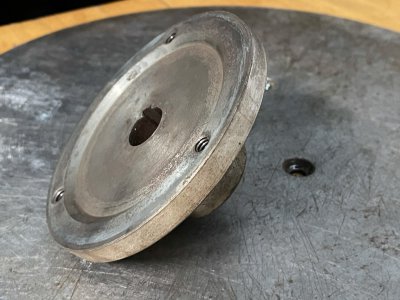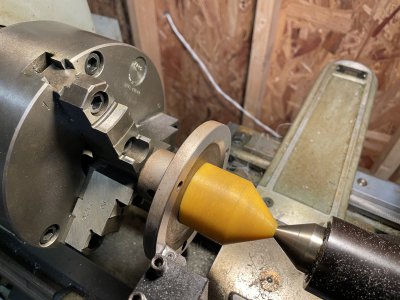I’m seeking a few points of guidance on truing my disc sander. It uses a hub with a woodruff key and two setscrews (one on the key, one at 90°), and the disc has three countersunk screws into the face of the hub. The shaft end has about 0.001” TIR (radial), which seems pretty good to me. The hub’s face where the disc mounts has about 0.009” TIR (axial), so that’s where I’m focused.

I'd really appreciate thoughts on the following:
(1) The keyway seems to complicate centering the hub’s bore in a 4-jaw. Can I run my DTI over that gap okay (turning slowly)? Or just go back and forth over the uninterrupted portion of the bore? My other idea was to make a short shaft the same diameter as the sander's shaft, secure it with a key and the two setscrews, then indicate off that, to try and replicate the operational condition. (I could use the actual shaft but it's a disc-belt sander, and would be a little involved to get the shaft out; it feels smooth so I have no need to replace bearings, etc.). I suppose that by using a shaft in the hub, I'm more likely to get the shaft parallel to the spindle axis, which is really what I care about. Addressing (2) below would take care of all this by creating new surfaces with the correct orientation.
(2) There is a little slop between the hub and the shaft; I didn't measure, but I can feel the hub rock a little before tightening the setscrews. improving the fit between the shaft and hub would be nice. My thought was to rebore the hub and press in a sleeve that could then be bored to match the shaft. I'm not sure it's worth it, as then I'd have to cut a keyway. I have no broaches; in a prior project I have made a keyway with the lathe-carriage-shaper approach, though that was aluminum and this would be steel.
(3) Once the hub is improved, I'll mount the disc on it and measure that (it's sitting under the hub in the picture). I'd love to be able to skim the face of the 12" disc. My lathe has a 12.25" swing over the bed. But the carriage's support means I won't be able to get the toolpost any closer than about 5" from the face of the disc. My thought is to use my largest boring bar (3/4" steel with a HSS bit) in a facing cut and hope for the best but I know that's beyond where such a bar performs best.
Thanks,
Jason

I'd really appreciate thoughts on the following:
(1) The keyway seems to complicate centering the hub’s bore in a 4-jaw. Can I run my DTI over that gap okay (turning slowly)? Or just go back and forth over the uninterrupted portion of the bore? My other idea was to make a short shaft the same diameter as the sander's shaft, secure it with a key and the two setscrews, then indicate off that, to try and replicate the operational condition. (I could use the actual shaft but it's a disc-belt sander, and would be a little involved to get the shaft out; it feels smooth so I have no need to replace bearings, etc.). I suppose that by using a shaft in the hub, I'm more likely to get the shaft parallel to the spindle axis, which is really what I care about. Addressing (2) below would take care of all this by creating new surfaces with the correct orientation.
(2) There is a little slop between the hub and the shaft; I didn't measure, but I can feel the hub rock a little before tightening the setscrews. improving the fit between the shaft and hub would be nice. My thought was to rebore the hub and press in a sleeve that could then be bored to match the shaft. I'm not sure it's worth it, as then I'd have to cut a keyway. I have no broaches; in a prior project I have made a keyway with the lathe-carriage-shaper approach, though that was aluminum and this would be steel.
(3) Once the hub is improved, I'll mount the disc on it and measure that (it's sitting under the hub in the picture). I'd love to be able to skim the face of the 12" disc. My lathe has a 12.25" swing over the bed. But the carriage's support means I won't be able to get the toolpost any closer than about 5" from the face of the disc. My thought is to use my largest boring bar (3/4" steel with a HSS bit) in a facing cut and hope for the best but I know that's beyond where such a bar performs best.
Thanks,
Jason

